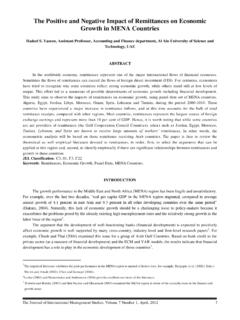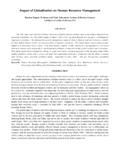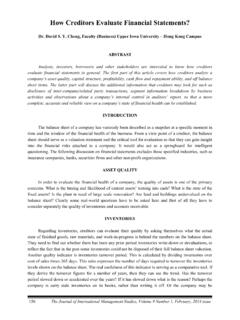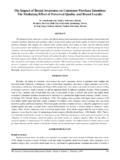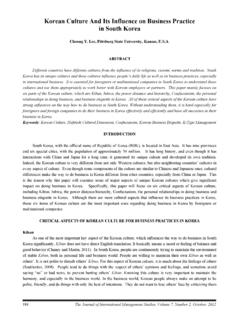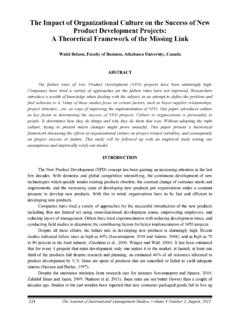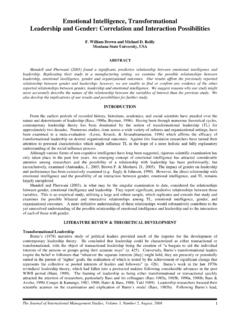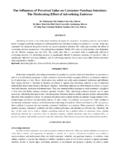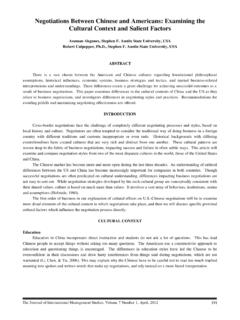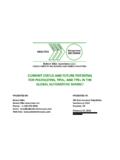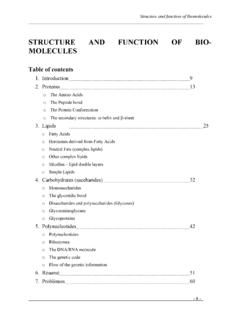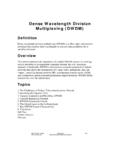Transcription of How the Pecking-Order Theory Explain Capital …
1 How the Pecking-Order Theory Explain Capital structure Li-Ju Chen, Graduate School of Business and Operations Management, Chang Jung Christian University, Taiwan Shun-Yu Chen, Department of Business Administration, Chang Jung Christian University, Taiwan ABSTRACT The pecking order Theory of Capital structure is one of the most influential theories of corporate finance. The purpose of this study is to explore the most important factors on a firm s Capital structure by Pecking-Order Theory . Hierarchical regression is used as the analysis model. This study examines the determinants of debt decisions for 305 Taiwan electronic companies that are quoted on the Taiwan Stock Exchange of 2009.
2 The results indicate that the determinants of Capital structure are profitability and growth rate. The profitability negatively affects on Capital structure . It implies that firms prefer to use their earnings to finance business activities and thus use less debt Capital . Growth rate positively affects to Capital structure . The greater growth opportunity will have more Capital structure to finance the growth. Size is a moderator variable in this study. Size of firms moderates the effects of tax rate on Capital structure . Large firms appear to take advantage of the tax deductibility of debt. The findings are important for management and investors.
3 Keywords: Corporate finance, Capital structure , pecking order Theory , Taiwan INTRODUCTION Effective financial management and what characters affect their Capital structure are important for a firm to obtain better operational performance. A false decision about the Capital structure may lead to financial distress and even to bankruptcy. There are numerous theories developed to analyze alternative Capital structures. Among all these theories, the static trade off Theory which derived by Modigliani and Miller (1963) was the earliest and most recognized which explains the formulation of Capital structure .
4 Their trade off Theory assumed that there are optimal Capital structures by trading off the benefits and cost of debt and equity. The main benefit of debt is tax deductibility of interest and the costs are bankruptcy cost (Kim, 1978) and agency cost (Jesen and Meckling, 1976; Myers, 1977). However, recent studies have shown a focus shift from the trade off Theory to pecking order Theory (Quan, 2002; Mazur, 2007). The pecking order Theory assumes that there is no target Capital structure . The firms choose capitals according to the following preference order : internal finance, debt, equity. Myers and Majluf (1984) argued the existence of information asymmetry between managers (insiders) and investors (outsiders).
5 They argued that managers have more inside information than investors and act in favor of old shareholders. Using corporate data from Taiwan electronic firms, we analyzed the cross-sectional data of electronic firms of 2009 and examine whether they follow the financing pattern implied by the pecking order Theory . LITERATURE REVIEW Modigliani and Miller (1958) were the pioneers in the theoretically examining the effect of Capital structure on the firm value. In the perfect Capital market, the Capital structure does not affect a firm s value. It is the Theory of Capital structure irrelevance that a firm s value depends on the ability of its assets to create value, and is irrelevant if the assets originate in internal Capital or external Capital .
6 Modigliani and Miller (1963) took taxation under consideration and proposed that the firms should employ as much debt as possible. Companies have an advantage in using debt rather than using internal Capital , as they can benefit from debt tax shields. This tax shield allows firms to pay lower tax than they should, when using debt Capital instead of using only their own Capital . The Theory argues that the more debt is, the more a firm s value is created. Jensen and Meckling (1976) identified the existence of the agency problem. They proposed that there are two kinds of agency costs - agency costs of equity and debt. The conflicts between managers and shareholders leads to agency costs of equity, and the conflicts between shareholders and debt-holders leads to agency costs of debt.
7 Usually, managers are interested in accomplishing their own targets which may differ from the firm value. The owners may try to monitor and control the managers behaviors. These monitoring and control actions results in agency costs of equity. When a lender provides money to a firm, the interest rate is based on the risk of the firm. Manager may tempt to transfer value from creditors to shareholders. These monitoring and control actions results in agency cost of debt. The trade off Theory indicates the exposure of the firm to bankruptcy and agency cost against tax benefits associated with debt use.
8 Bankruptcy cost is a cost directly incurred when the perceived probability that the firm will default on financing is greater than zero. One of the bankruptcy costs is liquidation cost, which represents the loss of value as a result of liquidating the net assets of the firm. Another bankruptcy cost is distress cost, which is the cost a firm incurs if stakeholders believe that the firm will discontinue. According to trade off Theory , companies are expected to look for a target debt ratio (Jalilvand and Harris, 1984). The pecking order Theory suggests that firms have a particular preference order for Capital used to finance their businesses (Myers and Majluf, 1984).
9 Owing to the information asymmetries between the firm and potential investors, the firm will prefer retained earnings to debt, short-term debt over long-term debt and debt over equity. Myers and Majluf (1984) argued that if firms issue no new security but only use it s retained earning to support the investment opportunities, the information asymmetric can be resolved. That implies that issuing equity becomes more expensive as asymmetric information insiders and outsiders increase. Firms which information asymmetry is large should issue debt to avoid selling under-priced securities. The Capital structure decreasing events such as new stock offering leads to a firm s stock price decline.
10 An announcement of increasing Capital structure events is received by the market as good news because financial intermediaries like investment bank can become insiders to monitor the firm s performance. Managers may have inside information that is not known to the market. Insider investors have more information about the true distribution of firm returns than outsiders. Insider investors tend to limit the use of equity in order to retain control of the firm (Hutchinson, 1995). Moreover, the risk of the firm s return is unknown to investors. They are forced to rely on noisy signals such as the firm s level of Capital structure to determine the risk of their investment and firm s value may be under-priced by the market (Myers and Majluf, 1984).
